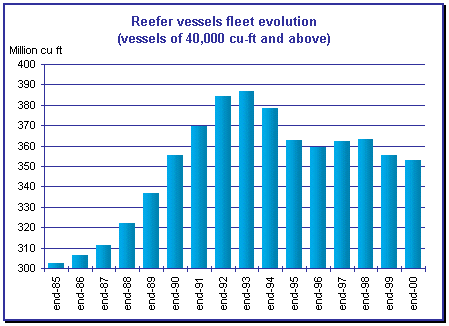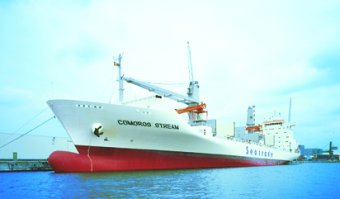
| The fleet
|
|
|
The world fleet of reeferships again declined in
numbers this year. By December 31st 2000, the fleet comprised 1,249
ships over 40,000 cu ft with a total capacity of about 353 million cu ft,
i.e. a decrease of roughly 1.1 % in the number of vessels and of 0.9 %
in the capacity, compared to Dec. 31st 1999.
Deliveries of new ships were down sharply, with only
13 deliveries with a capacity of 6.3 million cu ft in 2000, as against
20 vessels and a capacity of 9.5 million cu ft in 1999. These figures
are the lowest recorded since 1995.
The large-size vessels again maintained their
predominance, with about 85 % of delivered ships being over 300,000 cu
ft (90 % in 1999).
Only 4 new units are due for delivery in 2001, for a
total capacity around 1.9 million cu ft. The large sizes are still
dominant with some 75 % of these vessels having a capacity above 300,000
cu ft.

Despite the weakness in the market, it is surprising
to see the small number of vessels being withdrawn, scrapped, lost, or
converted. Only 27 ships were scrapped (versus 52 in 1999), comprising
9.5 million cu ft (16.8 million cu ft in 1999).
The above figures refer to refrigeration capacity in
ship holds. They should be weighted to take into account the increase in
the capacity of refrigerated containerships of delivered units, both on
reefers (about 2,490 teu / 2.49 million cu ft) and containerships (about
66,000 teu / 66 million cu ft). In fact the year 2000 has seen an
increase in the order of 65.5 million cu ft in the total supply of
refrigerated capacity.
Given current orders, it is expected that the market
in 2001 will reach a containerised refrigerated capacity of 93,000 teu /
93 million cu ft.
|
| New-buildings
|

|
|
Up until late in the year, in view of the above, one
might have expected that no new orders for refrigerated vessels would be
contracted in 2000. But in December, an order was placed by the German
company MPC Capital for two ships (with options for two additional) with
the Portuguese shipyard Viana do Castelo, for a reported unit price of
about US$ 30 million. These vessels with delivery expected in 2003, will
be chartered to Agrexo (a major exporter of citrus fruit from Israel)
for a 12 years' period. They will have the particularity of combining
a refrigerated capacity of 460,000 cu ft with a container capacity of
880 teu in hold and on deck, together with a 160 slots for refrigerated
containers. The service speed is 21 knots. These ships are built to be
multi-purpose (containers, cars, various products, etc.).
The number of deliveries (firm orders) expected in
2001 is only four ships for 1.9 million cu ft. These ships were ordered
in 1997 and 1998. Given the current market conditions, it is reasonable
to expect that newbuilding activity in 2001 will be severely reduced, if
not nil.
 |
COMOROS STREAM
abt 580,754 cbft, 11,382 dwt, blt 2000 by Kitanihon Zosen -
Disponent Owner: Seatrade Reefer Chartering NV
|
|
| The second-hand reefership market
|
 <
/td> <
/td>
|
|
No more than 70 sales were registered in total in
2000. However one should not be misled by this figure, as in fact the
second-hand sales of reefer ships were in fact extremely limited, with
only a handful of "representative ships" actually changing
hands during the year. The main operators remained very much on the
sidelines insofar as second-hand sales were concerned. Consequently,
apart from nearly a dozen sales to owners such as De Nadai, Laskaridis
or Del Monte, listed below, the "big" players preferred to
suffer in silence, in a market even more depressed than last year's.
The sale of assets between companies was really the only bright spark
during the course of the year.
One should nonetheless point out the solid resistance
of nearly all owners and their bankers in this morose market. There were
virtually no reports of forced sales, which certainly would not have
been the best solution given the depressed state of affairs. However
this situation should not ignore the intense financial activity behind
the scenes, and an attempt between owners and bankers and even between
just owners, to try to rationalise and restructure this activity.
Some representative sales :
- The 'Al Zohal 1', 'Teno' and 'Talca', sister-ships of
479,000 cu ft, 66 teu, 19 knots, built in 1986, 1988 and 1987, sold to
clients of Denadai by Unicoolship at $8m, $9m and $8,5m in February.
- The 'Roztocze', 'Kurpie', 'Kociewie', 'Powisle' and
'Podlasie', sister-ships of 290,000 cu ft, 17 knots, built in
1991, 1988, 1986, 1987 and 1988, sold to Greek interests by Transocean
for $8m each in December
- The 'Hachinohe Bay' and ' Kamishima', sister-ships of
302,050 cu ft, 16 knots, both built in 1991, sold to clients of
Lavinia Corp. by Yukono Marine and Unox Marine for $10m each.
- The 'Atlantic Mermaid' and 'Pacific Mermaid', sister-ships
of 540,000 cu ft, 80 teu, 19 knots, both built in 1992, sold to
clients of Elmira by Southern Route Maritime for $16m each.
|
| Conclusion and prospects
|

|
|
It appears premature to make predictions about the
2000-2001 season. However a number of factors already presage yet again
poor returns for owners.
- As mentioned above, a total refrigerated capacity of 96 million cu
ft should come onto the market in 2001.
- At the same time, potential scrappings in 2001 (ships of 23 years
or more in 2000) are only 54.2 million cu ft or some 275 vessels. It
is hard to imagine that such a number will be sold for scrap in just
one year. Over the past 20 years, the highest number of reeferships
to be scrapped in a single year was 85, for 23.5 million cu ft, in
1984.
- Even though a considerable reduction in the number of car carriers
is expected in 2001, 13 new ships should be delivered this year.
- Influenced by the spot rates of the 1999-2000 season, contracts
for the season 2000-2001 were renewed at identical levels to the
preceding year, at a late stage and for reduced quantities.
- After various unsuccessful proposals, a European banana import
system in compliance to WTO rules is still being worked on. Until a
final text can be agreed it is not possible to elaborate on any
comprehensive long term contracts.
- Banana prices are at low levels on all markets.
- There was a decline in the number of ships sold for scrap in 2000,
in marked contrast to 1999, even though this was contradictory to
market conditions. Owners of old vessels which do not comply either
to the norms or most of the charterers' requirements, still show
no inclination to make a collective step towards scrapping, even
though in short-term costs, current conditions do not justify them
being reactivated for some potential seasonal employment.
As was the case last year, we unfortunately do not
foresee any significant recovery in the market this year. The positive
economic signs of developed countries, and a reduction in the volume of
the refeership fleet, should have led to a substantial improvement in
freight rates, but the contrary has occurred. Paradoxically, an increase
in traffic with at the same time a decline in the refrigerated fleet,
has led to a reduction in freight levels. After the decisive turning
point in 1999, it seems that the transportation of perishable goods by
the traditional reeferships is on the decline, dominated by the process
of containerisation. It seems probable that we shall witness a
progressive switch from the transport of refrigerated goods to "all
containers", initially for seasonal products (Chile, South Africa,
Argentina, Brasil, New Zealand), and at a later stage for bananas and
fish.
The big operators of reeferships are aware of this
evolution, and certain - in collaboration with owners of containerships
' employ their reefers in parallel on some container routes.
The development of regular door-to-door parcel
service, minimising return voyages in ballast for all sorts of goods, is
another solution which will help improve the efficiency of existing
refeerships, especially if they have a good container capacity. This
system should be the spearhead of the new entity Lauritzen Cool between
South Africa and Europe. But the main basis of such a scheme is it not
the perfect set-up for' containerisation?
|
Shipping and Shipbuilding Markets in 2000
I N D E X
|